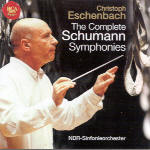Remember the classical music recording crisis? The glut of less-than-stellar recordings of basic repertoire? A problem so severe that BMG practically withdrew from the market entirely? Will they never learn? No, don’t answer that. It’s too depressing. Here’s the deal: Christoph Eschenbach recorded an unspectacular Schumann cycle with the Bamberg Symphony for Virgin Classics, recently reissued at budget price, and though this one offers marginally better playing and sound, it’s a complete mystery what possibly could have motivated BMG to issue this equally lackluster new cycle. Mind you, there’s nothing truly awful here. Eschenbach is a fine conductor and heaven knows he’s at home in Schumann. He does some lovely things, say, with the second and third movements of the Rhenish Symphony, or the Romanze of the Fourth. But in the Third Symphony’s chorale fourth movement what he no doubt intends as solemnity rapidly degenerates into somnolence, and the performance never really recovers.
First movements and finales in general pose orchestral balance problems that Eschenbach hasn’t quite solved. The appearance of the Fourth Symphony’s motto theme in the first movement development passes almost without incident, buried in an excess of strings. The opening of the Rhenish fails to give the cross rhythms the necessary emphasis (the first five notes of the principal theme on the violins are barely distinguishable), with backwardly balanced timpani and brass. The great horn call toward the movement’s end also needs more sheer power and majesty than Eschenbach allows it. Compare this to Günter Wand’s performances of the Third and Fourth Symphonies with the same orchestra, and the differences are telling: here’s a firmer bass foundation, steadier tempos, and the transparent sonority that the music demands.
Similarly, the outer movements of the first three symphonies (less so the Fourth) suffer from Eschenbach’s readiness to relax the tempo in lyrical passages, losing energy that he never quite recaptures. Even the Second Symphony’s scherzo, usually a sure-fire success, lacks sparkle and dynamic nuance. Standards in this music are very, very high. There’s Bernstein’s ferocious energy on Sony (out of print) and DG (grab it while you can), Sawallisch’s classic set with the marvelous Staatskapelle Dresden on EMI, Szell’s carefully detailed and magnificently played Sony cycle, Marriner’s surprisingly excellent and impulsive Hänssler recordings, and countless exceptional individual performances from the likes of Giulini (the Rhenish), Furtwängler (the Fourth), and Klemperer (First and Fourth). In a very competitive field, this set ranks as merely average.
































